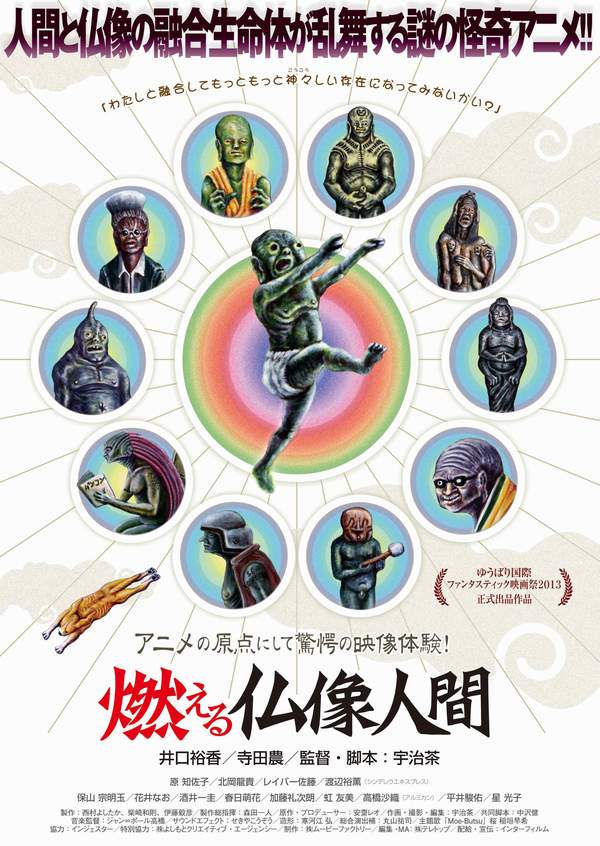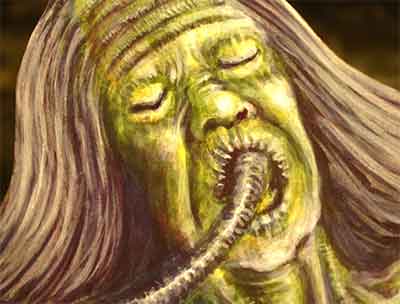 Cut-out animation, H.R. Giger-esque grotesquerie and Buddhism—an irresistible combination, I say, in a 2013 film that qualifies as a work of undeniable psychotic genius. BURNING BUDDHA MAN (MOERU BUTSUZO NINGEN) was done in the “gekimation” style, utilized fairly extensively in 1970s Japanese television but largely discarded in the ensuing years, that consists of still pictures moved around by an unseen hand, enhanced with actual smoke, flames and fluids (specifically blood and slime).
Cut-out animation, H.R. Giger-esque grotesquerie and Buddhism—an irresistible combination, I say, in a 2013 film that qualifies as a work of undeniable psychotic genius. BURNING BUDDHA MAN (MOERU BUTSUZO NINGEN) was done in the “gekimation” style, utilized fairly extensively in 1970s Japanese television but largely discarded in the ensuing years, that consists of still pictures moved around by an unseen hand, enhanced with actual smoke, flames and fluids (specifically blood and slime).
…pictures moved around by an unseen hand, enhanced with actual smoke, flames and fluids (specifically blood and slime).
The creator of this monstrosity was the Kyoto based Ujicha, who spent a reported three years making it (and his 2018 follow-up feature VIOLENCE VOYAGER) with a store-bought FujiFilm camera. It services a nutty narrative that incorporates various unique-to-itself names and terms (sample dialogue: “I’m sick of all the worthless Buddha statue maniacs like you!”), and filches plot points from THE FLY (1986 version), ALICE IN WONDERLAND and THE MATRIX.
The film begins and ends with indifferently lensed and acted live action sequences involving a young woman playing with the cut-out pictures that will come to serve as the film’s visuals. Those visuals involve Beniko, a little girl who’s just lost her parents and ends up in the care of the creepy monk Enju. He informs Beniko of a coalition of mutants known as Seaddattha that steals Buddha statues, using a transference device that causes people and animals to become fused with the statue if they’re standing near it–although if those people or animals happen to be inside the statue when it’s zapped they become severely deformed.
…the fascination exerted by the visuals holds one’s attention.
Beniko somehow winds up in the Seaddattha’s lair, where it’s revealed that these horrifically mutated folk, led by the walrus faced Shi-Senior, are actually the good guys. Their aim is not to steal but protect Buddha statues from an evil organization led by Enju, who’s responsible for the Seaddattha members’ mutations, as he used them all as subjects for his teleportation experiments. In order to resist Enju and his followers the Seaddattha take some drastic measures, such as transforming themselves into animals that are combined into a single being, and, in Beniko’s case, undergoing rigorous fight training on a virtual plane.
 This, keep in mind, only covers the first half, which is extremely wordy and expository. The second half is more action-oriented, with characters constantly “fusing” with and fighting each other, resulting in some of the most unusual fight scenes you’ll see in any film. There’s even some UROTSUKIDOJI-styled sexual shenanigans, with a lengthy snake-penis making its presence known, and a spiritually-oriented conclusion whose Buddhist leanings feel genuine.
This, keep in mind, only covers the first half, which is extremely wordy and expository. The second half is more action-oriented, with characters constantly “fusing” with and fighting each other, resulting in some of the most unusual fight scenes you’ll see in any film. There’s even some UROTSUKIDOJI-styled sexual shenanigans, with a lengthy snake-penis making its presence known, and a spiritually-oriented conclusion whose Buddhist leanings feel genuine.
…characters constantly “fusing” with and fighting each other, resulting in some of the most unusual fight scenes you’ll see in any film.
THE BURNING BUDDHA MAN may not always make sense, but the fascination exerted by the visuals holds one’s attention. No other film utilizes still pictures in quite the same way, with Ujicha giving those pictures a cinematic vocabulary that incorporates close-ups (showing faces that are more often than not contorted in expressions of fear or disgust), varied focus and expressive lighting.
Again, though, the live action intro and outro are a drag on an otherwise impressive whole. Quite simply, the live action segments add nothing, and conclude with an altogether superfluous observation: “There are many strange things happening in this world.” You don’t say!
Vital Statistics
THE BURNING BUDDHA MAN (MOERU BUTSUZO NINGEN)
Movie Factory/Tele Top Studio
Director: Ujicha
Producer: Takehiko Ito
Screenplay: Ujicha, Ken Nakazawa
Cast: Yuka Iguchi, Chisako Hara, Ryuki Kitaoka, Hiroshige Watanabe, Labor Sato, Nao Hanai, Moeka Haruhi, Minori Terada
